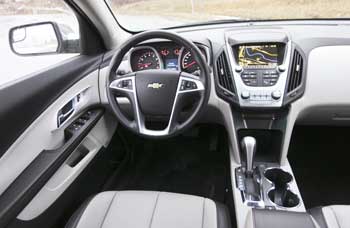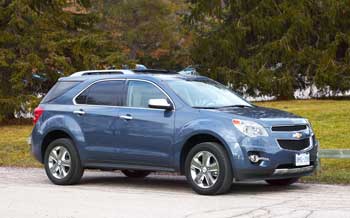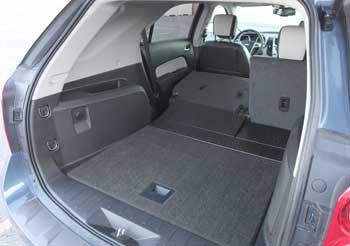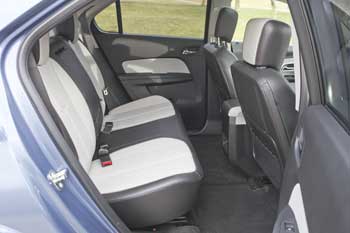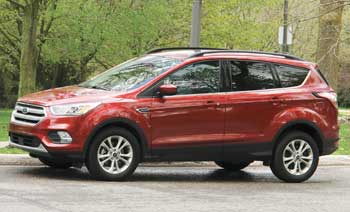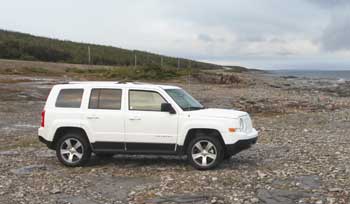Chevrolet Equinox 2010-2017: pros and cons, common problems
By Vlad Samarin. Updated: January 27, 2024.
The Equinox stands out as a versatile, mid-size crossover with a sleek design and practical features. It comes in front-wheel drive or all-wheel drive trims, with a 2.4-liter 4-cylinder or V6 engine.
In 2013, Chevrolet introduced a potent 3.6L V6 engine option replacing the optional 3.0L V6 in earlier models. The only transmission choice is a 6-speed automatic. The Equinox offers a stylish interior and comfortable and controlled driving experience.
- Functional Design: The Equinox offers a versatile mid-size crossover design with practical features and ample cargo and rear seat space.
- Fuel Efficiency: The front wheel drive Equinox with the 2.4-liter delivers good fuel economy: the 2014-2016 FWD 4-cylinder Equinox is rated at 22/31 MPG city/highway.
- Powerful V6 Engine Option: The 3.6L V6 engine in the 2013-plus Equinox provides extra power.
- Driving Experience: The Equinox offers a comfortable and controlled driving experience.
- Affordable: Compared to some other mid-size SUVs, the Equinox is priced lower.
Cons:
- Not Nimble: The Equinox is not as nimble or agile as some other SUVs. The large turning radius also makes it less maneuverable.
- Engine problems: The engine is a weak spot and will likely need some repairs. The price for a used engine is also quite high making the potential replacement costly.
- Material Quality: The quality of interior materials are not as good compared to some competitors.
- Advanced Safety Features: While equipped with basic safety features, advanced safety options are only available in some top-level trims.
- Infotainment System: The infotainment system is outdated compared to more modern systems.
- Rear Visibility: Thick rear pillars create blind spots, making changing lanes, parking and reversing more difficult.
The PCV system also needs to be checked regularly, especially if you noticed that the engine consumes oil.
The GM technical bulletin 17-NA-098 for the 2010-2012 Chevrolet Equinox/GMC Terrain with a 2.4L engine describes a problem where the engine runs rough, hesitates, is hard to start, and or stalls. During diagnosis, a technician may find codes P0010, P0013, P0011, or P0014.
According to the bulletin this problem could be caused by camshaft position actuator solenoid valve failure. The part is sold for around $48-$58 on Amazon and is fairly easy to replace. It's a very common issue in this vehicle. We found several YouTube videos describing this problem and repair.
Many Equinox owners mentioned timing chain kit replacement in the 2.4L 4-cylinder and V6 engines. If out of warranty, this repair might be quite expensive. Watch these videos describing the repair.
There are plenty of complaints about excessive oil consumption in early models. We noticed many of the reported engine problems are related to low oil level.
For this reason, if the Check Engine light comes on, or there is some noise from the engine, check the oil level first. It's a good idea to check the oil level on a regular basis and top it up as needed. Using premium synthetic oil and more frequent oil changes can also help.
Many owners have reported that one or both windshield wipers stop working without warning. This may be caused by a separated link ball socket in the wiper transmission. GM issued Special Coverage Adjustment N192266180 that covers this condition for a period of 10 years or 150,000 miles (240,000 km). Read more about the wiper transmission.
Stabilizer bar links are common to go bad and cause a knocking/clunking noise from the suspension when driving at a slow speed on an uneven surface. Stabilizer bar links are small parts in the front and rear suspension of the vehicle.
Advertisement
Replacing front or rear stabilizer bar links is not very expensive. If you hear a clunking noise from the suspension, have the vehicle checked out as soon as possible, as most of the suspension problem can make the vehicle unsafe to drive.
Bad front lower control arm rear bushings can cause a looseness in the front end, clunking or creaking noises from the front suspension or shaking/vibration when braking. We found several Youtube videos explaining the repair. The part is not very expensive and is fairly easy to replace.
A bad wheel bearing (wheel hub assembly) can cause a humming noise that is more noticeable at higher speeds.
Sometimes a bad wheel bearing can also cause the ABS or Stabilitrak Traction Control warning to come on. Replacing a front wheel bearing will cost 1.2-1.5 hours of labor (for one bearing) plus the part. There might be a diagnostic charge to check which bearing is bad. The ABS sensor of the affected wheel bearing can also be damaged and may need to be replaced. Read more about the ABS sensor. Watch these YouTube videos descriving the problem and the repair.
A failed A/C compressor may cause the air conditioner not to work. Replacing the A/C compressor may cost from $550 to $750.
Check for recalls at the NHTSA website.
Summary
The Equinox is a practical and fuctional vehicle with roomy, comfortable interior. Although the Equinox is not the most reliable one, it's better than some other mid size SUVs. As of January 2024, Consumer Reports rated the 2010-2017 Equinox "below average" for the overall reliability. Trouble spots include engine and exhaust.Given that many reported problems are related to the engine, consider buying an extended powertrain warranty with no limit per claim that will cover engine failures. A front-wheel drive model is better on gas and will be less costly to keep on the road in the long run. When buying a used Chevy Equinox, the condition of the engine is the key.
Using premium synthetic engine oil, checking the oil level regularly and doing more frequent oil changes may help avoid some of the engine problems.
The majority of reported problems on the forums and at the NHTSA website are related to the 2010-2014 Equinox. Considering this, earlier model years should be avoided or must be carefully checked out during the pre-purchase inspection, especially the engine. The 2015+ Chevy Equinox is a better option. The GMC Terrain is the mechanical twin of the Equinox and is pretty much the same car with different badge.
Related Reviews:
Ford Escape 2013-2019
Jeep Patriot 2007-2017
Subaru Outback 2010-2014
Toyota RAV4 2006-2012
Toyota RAV4 2013-2018
Honda CR-V 2007-2011
Honda CR-V 2012-2016
Mazda CX-5 2013-2016
Jeep Cherokee 2014-2020
Ford Edge 2007-2014
What to look for when buying a used Chevrolet Equinox? When buying a used Chevrolet Equinox, we suggest having the vehicle inspected by a qualified mechanic or even better, a GM dealership (not the one that sells the vehicle). If possible, discuss the findings directly with the mechanic doing the inspection.
Watch out for oil leaks from the engine or transmission. A low oil level may be an indication that the engine consumes oil. Avoid the vehicle if the engine sounds noisy, even if it's a short rattle when started cold. The rough idle, stalling and the Check Engine light are other indications of engine problems.
Watch out for rust damage, especially if the vehicle comes from the Salt Belt. Read more: How to inspect a used car - illustrated guide. During the test drive, watch out for abnormal transmission noises or rough shifting between gears. Read more: Signs of automatic transmission problems when test driving a used car.
2010-2017 Chevrolet Equinox Engines: The Equinox come with a standard direct-injected 182-hp 2.4L 4-cylinder Ecotec engine (codes LAF, LEA or LUK).
An optional direct-injected V6 is also available: The 2010-2012 Equinox comes with the 264-hp 3.0L V6 (LF1, LFW), while the 2013-2017 models have the 301-hp 3.6L V6 (code LFX).
Direct Fuel Injection means that the fuel is injected directly into the engine combustion chambers at high pressure, which improves the fuel efficiency. Read also: Pros and cons of buying a car with Direct Injection.
Timing belt or chain: Both the 4-cylinder and V6 engines have chain-driven camshafts. There is no timing belt.
Mechanical: The Equinox rides on the same GM Theta platform available with front- or all-wheel drive. Both vehicles have MacPherson struts in front suspension. The rear suspension uses an independent multi-link layout.
Front and rear brakes have ventilated discs. Anti-lock Brake System (ABS) is standard. In the 2.4L models, the steering is electrically assisted. The V6 models have a conventional hydraulic power rack-and-pinion steering. The only transmission choice is a 6-speed automatic.
Safety: The 2011-2017 Chevrolet Equinox received a four-star overall rating in government crash tests: 4 stars in frontal tests, 5 stars in side impact tests and 4 stars for rollover resistance.
